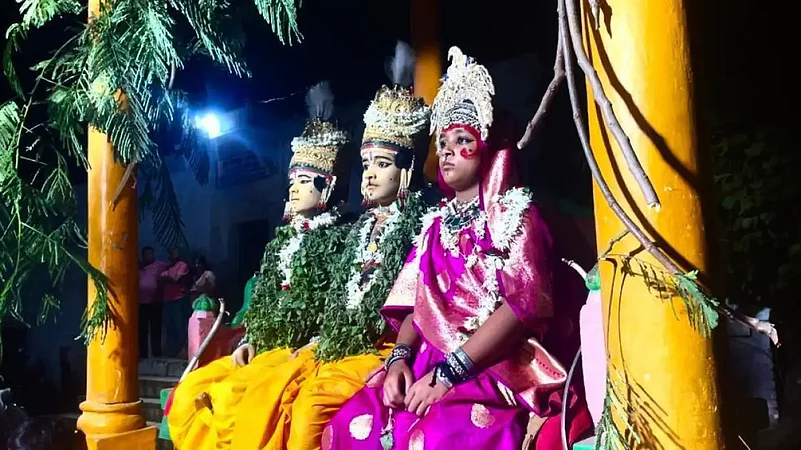Recently I had an argument on Facebook with a Malayali poet. She believed that the Ramlilas in Banaras began only after Goswami Tulsidas had written the Ramcharitmanas, although this is not true. Many of the Banaras Ramlilas are traditions older than the Manas. Conversely, the Ramlilas of Varanasi were among the inspirations for Tulsi to write the story of Lord Ram.
There is an interesting scene in the Adhyatma Ramayana: Ram is about to leave for the forest. Sita is adamant on accompanying him, although he tries to dissuade her citing the hardships they will face, that there are dangerous animals such as lions, bears and boars, there are scary monsters, the weather is often bad, that one has to walk barefoot on thorny paths etc.
However, this has no effect on Sita, and she rebukes him with a reason that may have convinced Ram but is also of great significance to us. She asks: “In all the Ramayanas that you have read and listened to, have you ever seen Sita not accompany Ram to the forest?”
Hence, we must acknowledge: there are many Ramayanas, and as many Rams.
Have you seen those wooden nesting dolls, which contain a similar smaller doll inside, and then another of the same inside that one, and so on? It continues until the smallest doll at the most interior level, which finally does not contain any more dolls inside because it cannot. But in our imagination, there could have been another, and the process could have continued to eternity.
Banaras presents a similar challenge: here, a different tradition springs up from inside a tradition, in an eternal continuum. Even the newest and novel aspect appears to be developing from an older thing. Thus, the observer can easily impose an ‘old’ on everything new here.
It was here that Tulsidas studied Sanskrit, and later rewrote the story of Lord Ram, based on the Sankrit Ramayana, in a commonly spoken tongue of north India. This was a transgression. The proud Sanskrit scholars of Banaras derided the common tongue as “bhakha” (a lesser version of bhasha – language) and considered it a medium of the uncultured. How could you narrate the feats of a carnation of Vishnu in a tongue which reeked of sweat and wore the dust of the street on its sleeves? A dialect which had no discipline of grammar and could be understood by an average Joe.
By the 16th century, no Ramayana had been written in any of the north Indian languages. The Lord languages were ahead in this context. Tamil, Telugu and Bangla had their own ramayanas by then. The Bhakti (Indian devotional-mystic tradition) rose from the South and spread slowly until it reached the banks of the Ganga. The Goswami (Tulsidas) took this task upon himself and began to translate the sentiment behind Valmiki’s 24,000 Sanskrit verses into a language breathed by crores of people.
Banaras is a battleground, and Tulsidas knew it. He had to prove his mettle among these scholars not just in terms of talent and philosophy but also in his command on language. He had trained in Sanskrit but was telling his tale in Awadhi. He took refuge in the city’s south, near the Assi ghat. However, the Banarasis were scoundrels of the highest order. They would not let him be in peace: someone would pull the end of his dhoti from behind, another would throw pebbles at him. He faced constant humiliation and ridicule. He may have been abused too, though we do not know, neither do care.
What is certain is that Tulsidas had the sense to become one with the Banaras rhythm and cross the Ganga without sinking. He dissolved in these civilizational waters like sugar. This is not an episode, rather it is a long artistic process. Tulsidas not just presented a challenge to Banaras from within, he also managed to change it.
The ancient lord of Banaras is Shiva, the sovereign of the city of Kashi. However, the Goswami had to tell the tale of Ram. He had to sing a Vaishnavite melody in the court of Shaivites. So he found an ingenious solution. He turned Shiva into the narrator, who is telling this tale and Parvati is listening to it. Similarly, many of us complain that the character of Ram, built on the ideals of the perfect man with self-control (maryada purushottam), is lacking in thrill and action. But Tulsi made up for this deficit by turning Hanuman into a classic hero.
He built a temple of Hanuman in the part of Banaras where he stayed and got people from different disciplines involved with it. The wrestlers, folk-singers, actors, peasants and labourers, who found no place in the elite circles dominated by Sanskrit and Persian, found themselves welcome in Tulsidas’ temple and akhara (traditional gymnasium for wrestling and hanging out). It became impossible to ignore Tulsidas once he gained this popular support.
This is the point where Ramlila comes in. There are documents that confirm that Ramlilas were being enacted in Banaras from the times before Tulsidas. In a 1908 judgement of the Allahabad High Court, Justices Stanley and Banerjee had held that Megha Bhagat, the organizer of the oldest Ramila in Banaras, was alive in 1543 and had been organizing performances. Even within the Manas, Tulsidas has described seeing these performances in different places. However, the Ramlila had not become a people’s festival until then.
It is Tulsidas and the Ramcharitmanas who took it to the people and gave birth to a unique people’s theatre. People from all castes, groups, religions and beliefs took part in this process, and the tradition continues to the day. The term Ganja-Jamuni tehzeeb (the syncretic culture of India) is often used in rhetoric, but it is actually reflected in the roots of Ramlila and the culture of Banaras. The crowns for the deities are made by Muslims. The bard who sings the verses of Ramcharitmanas is a Brahmin. The Gujarati community is in charge of dressing up and adorning the gods. Muslims again take care of the fireworks and building the effigies. The Yadavs pull the chariot. All this is not the result of a contemporary well-intentioned exercise, it is the organic practice developed by a community over 500 years.
Tulsidas and the Ramcharitmanas peaked in the popular psyche in the 19th and 20th centuries, beginning here, in Varanasi. There were two important incidents: firstly the beginning of the Ramnagar ramlila. The prince had fallen sick, and his mother pledged to organize ramlilas every year in Ramnagar - on the other side of Ganga - just like the Banaras ones, if the gods cured her son. When the son recovered, preparations were launched to organize the ramlila. The king invited the founder of modern Hindi literature, Bhartendu Harishchandra – who was a family friend – and tasked him with writing an imaginative play based on the Ramcharitmanas. The author produced a script which took into account the requirements of the stage, apart from the religious beliefs. Even today, this ramila largely follows the same script.
The other major development took place in the 20th century, when Hindi critic Ramchandra Shukla established Tulsi as the biggest medieval poet and Ramcharitmanas as the biggest work, even within the intellectual sphere. He established a formula- lokmangal (people’s interest), which says that the form that the divine theatre takes, in an attempt to push away the shadow of widespread injustice in the world, is beautiful even in its dreadfulness. This means that the violence that is produced in eliminating Ravana and other symbols of evil, is not only just, but also inherently beautiful.
This aspect helped the Manas gain exceptional popularity in the people’s psyche compared to the other Ramayanas. The dominance of Ramcharitmanas vis-a-vis the other ramayanas of India can also be read as a metaphor for Hindi’s supremacy compared to other Indian languages.
In the meantime, the west has also made several attempts to understand the ramlila. Noted American dramatist Richard Schechne was fascinated by the level of audience participation in this unique theatre. The spectators of the Ramnagar ramila are so regular, that they have assumed a special identity of the ‘Nemi.’ During that entire month, the Nemis do not do anything other than watching the ramlila. The festival is like a life ritual for them, linked to their faith. They arrive at the stage hours before the performance.
The ritual is fixed in the stages of taking a bath right there, praying, wearing bright white dhotis and vests, applying kohl to the eyes, consuming bhaang (cannabis), and getting ready to get engrossed with a palm fan in one hand and a copy of the Ramcharitmanas in the other. A wooden mini-stool forms the seat. During the entire performance, the spectators keep matching the singing on stage with the original text.
Across the world, this is the only place where you may find thousands of spectators who read the base text as they watch theatre. Schechner gives a term for this: the “theatre of environment.” In his own theatre, Schechner tried to establish this environment by handing the audience a glass of alcohol. However, he did not realize that modern theatre cannot fully emulate the ramlila. We have a 20 by 30 feet stage, while the ramlila has an area spread over 15 kilometres.
The birth (of Ram) is enacted at one place, the childhood somewhere else, while his youth moves to another location. After a dialogue, Ram is carried five kilometres away on shoulders, and a crowd of lakhs of people follows him. This culture, this experience, cannot be replicated in a different form. This is an experience beyond spirituality, beyond even art. This intense and constant shift between the formal and informal, person and character, spectator and performer, is impossible in the realm of modernity.
Be as it may, when all of us have become well-used to the world as a dazzling screen due to the shock of Covid, one still hopes that someday our new generation would also come to Banaras and experience this invaluable treasure of ramlila, and look at this beautiful but unembellished ceremony with new eyes.





















